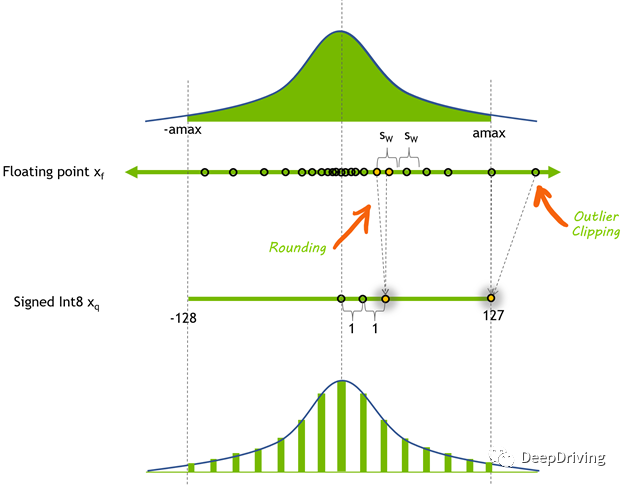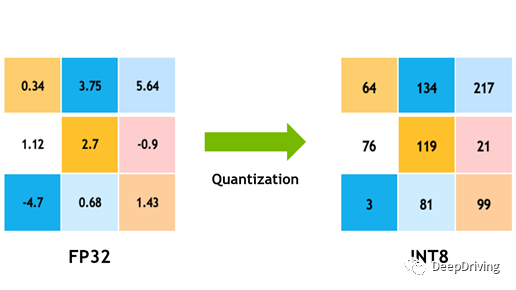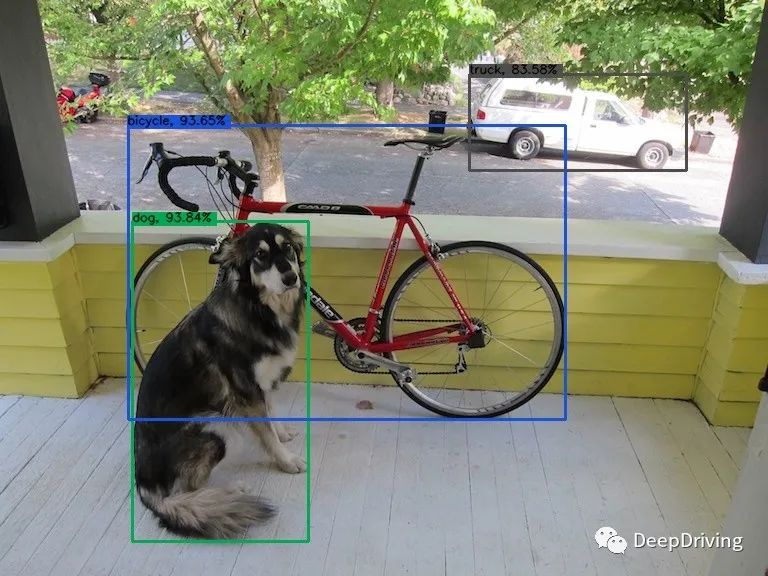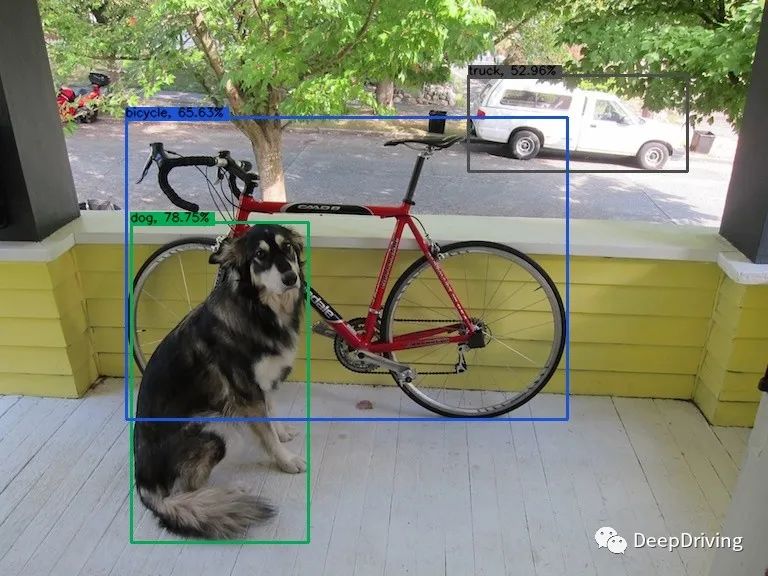
以下文章来源于知乎:DeepDriving
作者:一天到晚潜水的鱼
链接:https://mp.weixin.qq.com/s/IQTCUs8CcfgHxJCyV6cm3w
本文仅用于学术分享,如有侵权,请联系后台作删文处理

概述
32位浮点(FP32)来表示,以便能有更大的动态范围用于在训练过程中更新参数。然而在推理阶段,采用FP32的精度会消耗较多的计算资源和内存空间,为此,在部署模型的时候往往会采用降低模型精度的方法,用16位浮点(FP16)或者8位有符号整型(INT8)来表示。从FP32转换为FP16一般不会有什么精度损失,但是FP32转换为INT8则可能会造成较大的精度损失,尤其是当模型的权重分布在较大的动态范围内时。
虽然有一定的精度损失,但是转换为INT8也会带来很多好处,比如减少对存储空间、内存、CPU的占用,提升计算吞吐量等,这在计算资源受限的嵌入式平台是很有意义的。
把模型参数张量从FP32转换为INT8,也就是将浮点张量的动态范围映射到[-128,127]的范围,可以使用下面的公式:

FP32转换为INT8的关键是需要设置一个比例因子来做映射,这个映射过程就叫做量化,上面的公式是对称量化的公式。
「训练后量化」(
Post-training quantization,PTQ)是在模型训练好后,再通过一个「校准」(Calibration)流程去计算比例因子,从而实现量化过程。「量化感知训练」(
Quantization-aware training,QAT)是在模型训练过程中去计算比例因子,允许在训练过程中补偿量化和反量化操作带来的精度误差。
TensorRT的Python接口实现INT8量化。关于INT8量化的理论知识,由于牵涉的内容比较多,等我有空再专门写一篇文章来做介绍。TensorRT INT8量化的具体实现
TensorRT中的校准器
TensorRT需要计算模型中每个张量的比例因子,这个过程被称为校准。校准过程中需要提供具有代表性的数据,以便TensorRT在这个数据集上运行模型然后收集每个张量的统计信息用于寻找一个最佳的比例因子。寻找最佳比例因子需要平衡离散化误差(随着每个量化值表示的范围变大而变大)和截断误差(其值被限制在可表示范围的极限内)这两个误差源,TensorRT提供了几种不同的校准器:「IInt8EntropyCalibrator2」:当前推荐的熵校准器,默认情况下校准发生在层融合之前,推荐用于
CNN模型中。「IInt8MinMaxCalibrator」:该校准器使用激活分布的整个范围来确定比例因子,默认情况下校准发生在层融合之前,推荐用于
NLP任务的模型中。「IInt8EntropyCalibrator」:该校准器是
TensorRT最原始的熵校准器,默认情况下校准发生在层融合之后,目前已不推荐使用。「IInt8LegacyCalibrator」:该校准器需要用户进行参数化,默认情况下校准发生在层融合之后,不推荐使用。
TensorRT构建INT8模型引擎时,会执行下面的步骤:构建一个 32位的模型引擎,然后在校准数据集上运行这个引擎,然后为每个张量激活值的分布记录一个直方图;从直方图构建一个校准表,为每个张量计算出一个比例因子; 根据校准表和模型的定义构建一个 INT8的引擎。
GPU的计算机上生成校准表,然后在Jetson Nano等嵌入式平台上去使用。为了编码方便,我们可以用Python编程来实现INT8量化过程来生成校准表。具体实现
1. 加载校准数据
JPG格式的图片,图片读取后需要根据模型的输入数据要求进行缩放、归一化、交换通道等预处理操作:class CalibDataLoader:
def __init__(self, batch_size, width, height, calib_count, calib_images_dir):
self.index = 0
self.batch_size = batch_size
self.width = width
self.height = height
self.calib_count = calib_count
self.image_list = glob.glob(os.path.join(calib_images_dir, "*.jpg"))
assert (
len(self.image_list) > self.batch_size * self.calib_count
), "{} must contains more than {} images for calibration.".format(
calib_images_dir, self.batch_size * self.calib_count
)
self.calibration_data = np.zeros((self.batch_size, 3, height, width), dtype=np.float32)
def reset(self):
self.index = 0
def next_batch(self):
if self.index < self.calib_count:
for i in range(self.batch_size):
image_path = self.image_list[i + self.index * self.batch_size]
assert os.path.exists(image_path), "image {} not found!".format(image_path)
image = cv2.imread(image_path)
image = Preprocess(image, self.width, self.height)
self.calibration_data[i] = image
self.index += 1
return np.ascontiguousarray(self.calibration_data, dtype=np.float32)
else:
return np.array([])
def __len__(self):
return self.calib_count
def Preprocess(input_img, width, height):
img = cv2.cvtColor(input_img, cv2.COLOR_BGR2RGB)
img = cv2.resize(img, (width, height)).astype(np.float32)
img = img / 255.0
img = np.transpose(img, (2, 0, 1))
return img
2. 实现校准器
TensorRT提供的四个校准器类中的一个,然后重写父校准器的几个方法:get_batch_size: 用于获取batch的大小get_batch: 用于获取一个batch的数据read_calibration_cache: 用于从文件中读取校准表write_calibration_cache: 用于把校准表从内存中写入文件中
CNN模型,所以选择继承IInt8EntropyCalibrator2校准器:import tensorrt as trt
import pycuda.driver as cuda
import pycuda.autoinit
class Calibrator(trt.IInt8EntropyCalibrator2):
def __init__(self, data_loader, cache_file=""):
trt.IInt8EntropyCalibrator2.__init__(self)
self.data_loader = data_loader
self.d_input = cuda.mem_alloc(self.data_loader.calibration_data.nbytes)
self.cache_file = cache_file
data_loader.reset()
def get_batch_size(self):
return self.data_loader.batch_size
def get_batch(self, names):
batch = self.data_loader.next_batch()
if not batch.size:
return None
# 把校准数据从CPU搬运到GPU中
cuda.memcpy_htod(self.d_input, batch)
return [self.d_input]
def read_calibration_cache(self):
# 如果校准表文件存在则直接从其中读取校准表
if os.path.exists(self.cache_file):
with open(self.cache_file, "rb") as f:
return f.read()
def write_calibration_cache(self, cache):
# 如果进行了校准,则把校准表写入文件中以便下次使用
with open(self.cache_file, "wb") as f:
f.write(cache)
f.flush()
3. 生成INT8引擎
FP32模型引擎的流程我之前在一篇文章里专门介绍过,不过那篇文章里是用C++实现的。调用Python接口实现其实更简单,具体代码如下:def build_engine():
builder = trt.Builder(TRT_LOGGER)
network = builder.create_network(1 << (int)(trt.NetworkDefinitionCreationFlag.EXPLICIT_BATCH))
config = builder.create_builder_config()
parser = trt.OnnxParser(network, TRT_LOGGER)
assert os.path.exists(onnx_file_path), "The onnx file {} is not found".format(onnx_file_path)
with open(onnx_file_path, "rb") as model:
if not parser.parse(model.read()):
print("Failed to parse the ONNX file.")
for error in range(parser.num_errors):
print(parser.get_error(error))
return None
print("Building an engine from file {}, this may take a while...".format(onnx_file_path))
# build tensorrt engine
config.set_memory_pool_limit(trt.MemoryPoolType.WORKSPACE, 1 * (1 << 30))
if mode == "INT8":
config.set_flag(trt.BuilderFlag.INT8)
calibrator = Calibrator(data_loader, calibration_table_path)
config.int8_calibrator = calibrator
else mode == "FP16":
config.set_flag(trt.BuilderFlag.FP16)
engine = builder.build_engine(network, config)
if engine is None:
print("Failed to create the engine")
return None
with open(engine_file_path, "wb") as f:
f.write(engine.serialize())
return engine
OnnxParser去解析模型,然后通过config设置引擎的精度。如果是构建INT8引擎,那么需要设置相应的Flag,并且要把之前实现的校准器对象传入其中,这样在构建引擎时TensorRT就会自动读取校准数据去生成校准表。测试结果
INT8量化的效果,我用YOLOv5的几个模型在GeForce GTX 1650 Ti显卡上做了一下对比测试。不同精度的推理耗时测试结果如下:| 模型 | 输入尺寸 | 模型精度 | 推理耗时(ms) |
|---|---|---|---|
| yolov5s.onnx | 640x640 | INT8 | 7 |
| yolov5m.onnx | 640x640 | INT8 | 10 |
| yolov5l.onnx | 640x640 | INT8 | 15 |
| yolov5s.onnx | 640x640 | FP32 | 12 |
| yolov5m.onnx | 640x640 | FP32 | 23 |
| yolov5l.onnx | 640x640 | FP32 | 45 |
yolov5l模型FP32和INT8精度的目标检测结果分别如下面两张图片所示:


参考资料
https://developer.nvidia.com/zh-cn/blog/tensorrt-int8-cn/ https://developer.nvidia.com/blog/chieving-fp32-accuracy-for-int8-inference-using-quantization-aware-training-with-tensorrt/ https://docs.nvidia.com/deeplearning/tensorrt/archives/tensorrt-861/developer-guide/index.html#working-with-int8 https://github.com/xuanandsix/Tensorrt-int8-quantization-pipline.git

推荐阅读

AIHIA | AI人才创新发展联盟2023年盟友招募

AIHIA | AI人才创新发展联盟2023年盟友招募

AI融资 | 智能物联网公司阿加犀获得高通5000W融资

AI融资 | 智能物联网公司阿加犀获得高通5000W融资

Yolov5应用 | 家庭安防告警系统全流程及代码讲解

江大白 | 这些年从0转行AI行业的一些感悟

Yolov5应用 | 家庭安防告警系统全流程及代码讲解

江大白 | 这些年从0转行AI行业的一些感悟

《AI未来星球》陪伴你在AI行业成长的社群,各项福利重磅开放:
(1)198元《31节课入门人工智能》视频课程;
(2)大白花费近万元购买的各类数据集;
(3)每月自习活动,每月17日星球会员日,各类奖品送不停;
(4)加入《AI未来星球》内部微信群;
还有各类直播时分享的文件、研究报告,一起扫码加入吧!


大家一起加油! 
内容中包含的图片若涉及版权问题,请及时与我们联系删除



评论
沙发等你来抢